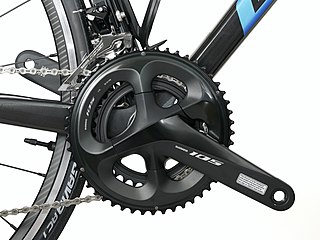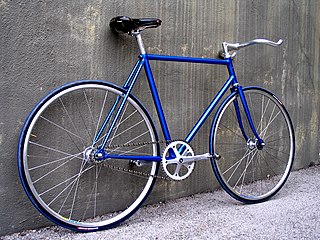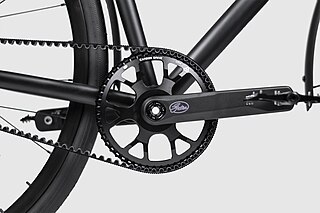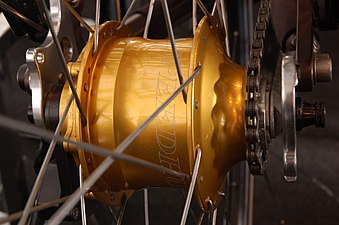
A derailleur is a variable-ratio bicycle gearing system consisting of a chain, multiple sprockets of different sizes, and a mechanism to move the chain from one sprocket to another.

A hub gear, internal-gear hub, internally geared hub or just gear hub is a gear ratio changing system commonly used on bicycles that is implemented with planetary or epicyclic gears. The gears and lubricants are sealed within the shell of the hub gear, in contrast with derailleur gears where the gears and mechanism are exposed to the elements. Changing the gear ratio was traditionally accomplished by a shift lever connected to the hub with a Bowden cable, and twist-grip style shifters have become common.

A differential is a gear train with three drive shafts that has the property that the rotational speed of one shaft is the average of the speeds of the others. A common use of differentials is in motor vehicles, to allow the wheels at each end of a drive axle to rotate at different speeds while cornering. Other uses include clocks and analogue computers. Differentials can also provide a gear ratio between the input and output shafts. For example, many differentials in motor vehicles provide a gearing reduction by having fewer teeth on the pinion than the ring gear.

The crankset or chainset is the component of a bicycle drivetrain that converts the reciprocating motion of the rider's legs into rotational motion used to drive the chain or belt, which in turn drives the rear wheel. It consists of one or more sprockets, also called chainrings or chainwheels attached to the cranks, arms, or crankarms to which the pedals attach. It is connected to the rider by the pedals, to the bicycle frame by the bottom bracket, and to the rear sprocket, cassette or freewheel via the chain.

A bicycle chain is a roller chain that transfers power from the pedals to the drive-wheel of a bicycle, thus propelling it. Most bicycle chains are made from plain carbon or alloy steel, but some are nickel-plated to prevent rust, or simply for aesthetics.

An epicyclic gear train is a gear reduction assembly consisting of two gears mounted so that the center of one gear revolves around the center of the other. A carrier connects the centers of the two gears and rotates, to carry the planet gear(s) around the sun gear. The planet and sun gears mesh so that their pitch circles roll without slip. If the sun gear is held fixed, then a point on the pitch circle of the planet gear traces an epicycloid curve.

A touring bicycle is a bicycle designed or modified to handle bicycle touring. To make the bikes sufficiently robust, comfortable and capable of carrying heavy loads, special features may include a long wheelbase, frame materials that favor flexibility over rigidity, heavy duty wheels, and multiple mounting points.

In mechanical or automotive engineering, a freewheel or overrunning clutch is a device in a transmission that disengages the driveshaft from the driven shaft when the driven shaft rotates faster than the driveshaft. An overdrive is sometimes mistakenly called a freewheel, but is otherwise unrelated.

Sturmey-Archer was a manufacturing company originally from Nottingham, England. It primarily produced bicycle hub gears, brakes and a great many other sundry bicycle components, most prominently during its heyday as a subsidiary of the Raleigh Bicycle Company. In the past, it also manufactured motorcycle hubs, gearboxes and engines.

A single-speed bicycle is a type of bicycle with a single gear ratio. These bicycles are without derailleur gears, hub gearing or other methods for varying the gear ratio of the bicycle.

A fixed-gear bicycle is a bicycle that has a drivetrain with no freewheel mechanism such that the pedals always will spin together with the rear wheel. The freewheel was developed early in the history of bicycle design but the fixed-gear bicycle remained the standard track racing design. More recently the "fixie" has become a popular alternative among mainly urban cyclists, offering the advantage of simplicity compared with the standard multi-geared bicycle.

Gear inches is an imperial measure corresponding to the diameter in inches of the drive wheel of a penny-farthing bicycle with equivalent (direct-drive) gearing. A commonly used metric alternative is known as metres of development or rollout distance, which specifies how many metres a bicycle travels per revolution of the crank.

On a bicycle, the cassette or cluster is the set of multiple sprockets that attaches to the hub on the rear wheel. A cogset works with a rear derailleur to provide multiple gear ratios to the rider. Cassettes come in two varieties, freewheels or cassettes, of which cassettes are a newer development. Although cassettes and freewheels perform the same function and look almost the same when installed, they have important mechanical differences and are not interchangeable.

Bicycle gearing is the aspect of a bicycle drivetrain that determines the relation between the cadence, the rate at which the rider pedals, and the rate at which the drive wheel turns.

A belt-driven bicycle is a chainless bicycle that uses a flexible belt, typically a synchronous toothed design, in order to transmit power from the pedals to the wheel.
Micro drive is a type of bicycle drivetrain, mostly BMX and MTB, that uses smaller than standard-sized sprockets. The smallest rear sprocket that fits on a freehub body is a 10 or 11-tooth, but with the use of a cassette hub, sometimes called a micro drive rear hub, sprockets as small as 8 teeth may be used.

Rohloff AG is a German company from Fuldatal near Kassel that manufactures hub gears, bicycle chains and tools that are known for their durability and high performance. The company's logo is a black silhouette of a raven on a yellow background.

Nuvinci Cycling technology currently under development for other applications, including wind turbines, light electric vehicles, outdoor power equipment, and automotive front-end accessory drives.

A Schlumpf Drive is a two-speed planetary gear assembly for use on bicycles and unicycles. It is distinct from other bicycle planetary gear assemblies in that it is located behind the chainring rather than in the rear hub. A push-button on each side of the axle allows the rider to switch between high and low ratios. These are operated by the rider's heel.


























